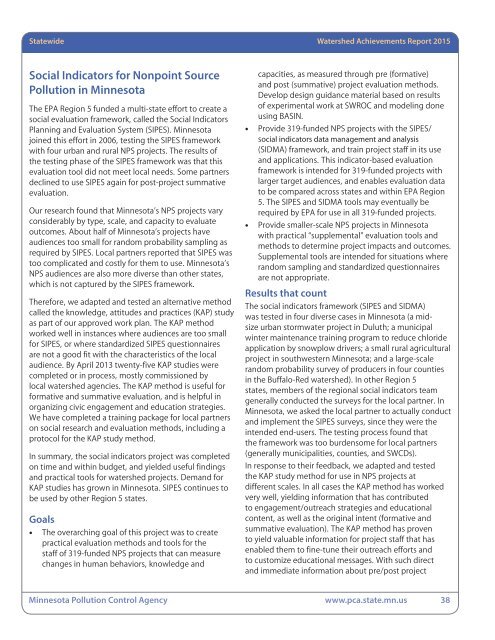Watershed Achievements Report
wq-cwp8-18
wq-cwp8-18
You also want an ePaper? Increase the reach of your titles
YUMPU automatically turns print PDFs into web optimized ePapers that Google loves.
Statewide <strong>Watershed</strong> <strong>Achievements</strong> <strong>Report</strong> 2015<br />
Social Indicators for Nonpoint Source<br />
Pollution in Minnesota<br />
The EPA Region 5 funded a multi-state effort to create a<br />
social evaluation framework, called the Social Indicators<br />
Planning and Evaluation System (SIPES). Minnesota<br />
joined this effort in 2006, testing the SIPES framework<br />
with four urban and rural NPS projects. The results of<br />
the testing phase of the SIPES framework was that this<br />
evaluation tool did not meet local needs. Some partners<br />
declined to use SIPES again for post-project summative<br />
evaluation.<br />
Our research found that Minnesota’s NPS projects vary<br />
considerably by type, scale, and capacity to evaluate<br />
outcomes. About half of Minnesota’s projects have<br />
audiences too small for random probability sampling as<br />
required by SIPES. Local partners reported that SIPES was<br />
too complicated and costly for them to use. Minnesota’s<br />
NPS audiences are also more diverse than other states,<br />
which is not captured by the SIPES framework.<br />
Therefore, we adapted and tested an alternative method<br />
called the knowledge, attitudes and practices (KAP) study<br />
as part of our approved work plan. The KAP method<br />
worked well in instances where audiences are too small<br />
for SIPES, or where standardized SIPES questionnaires<br />
are not a good fit with the characteristics of the local<br />
audience. By April 2013 twenty-five KAP studies were<br />
completed or in process, mostly commissioned by<br />
local watershed agencies. The KAP method is useful for<br />
formative and summative evaluation, and is helpful in<br />
organizing civic engagement and education strategies.<br />
We have completed a training package for local partners<br />
on social research and evaluation methods, including a<br />
protocol for the KAP study method.<br />
In summary, the social indicators project was completed<br />
on time and within budget, and yielded useful findings<br />
and practical tools for watershed projects. Demand for<br />
KAP studies has grown in Minnesota. SIPES continues to<br />
be used by other Region 5 states.<br />
Goals<br />
• The overarching goal of this project was to create<br />
practical evaluation methods and tools for the<br />
staff of 319-funded NPS projects that can measure<br />
changes in human behaviors, knowledge and<br />
capacities, as measured through pre (formative)<br />
and post (summative) project evaluation methods.<br />
Develop design guidance material based on results<br />
of experimental work at SWROC and modeling done<br />
using BASIN.<br />
• Provide 319-funded NPS projects with the SIPES/<br />
social indicators data management and analysis<br />
(SIDMA) framework, and train project staff in its use<br />
and applications. This indicator-based evaluation<br />
framework is intended for 319-funded projects with<br />
larger target audiences, and enables evaluation data<br />
to be compared across states and within EPA Region<br />
5. The SIPES and SIDMA tools may eventually be<br />
required by EPA for use in all 319-funded projects.<br />
• Provide smaller-scale NPS projects in Minnesota<br />
with practical “supplemental” evaluation tools and<br />
methods to determine project impacts and outcomes.<br />
Supplemental tools are intended for situations where<br />
random sampling and standardized questionnaires<br />
are not appropriate.<br />
Results that count<br />
The social indicators framework (SIPES and SIDMA)<br />
was tested in four diverse cases in Minnesota (a midsize<br />
urban stormwater project in Duluth; a municipal<br />
winter maintenance training program to reduce chloride<br />
application by snowplow drivers; a small rural agricultural<br />
project in southwestern Minnesota; and a large-scale<br />
random probability survey of producers in four counties<br />
in the Buffalo-Red watershed). In other Region 5<br />
states, members of the regional social indicators team<br />
generally conducted the surveys for the local partner. In<br />
Minnesota, we asked the local partner to actually conduct<br />
and implement the SIPES surveys, since they were the<br />
intended end-users. The testing process found that<br />
the framework was too burdensome for local partners<br />
(generally municipalities, counties, and SWCDs).<br />
In response to their feedback, we adapted and tested<br />
the KAP study method for use in NPS projects at<br />
different scales. In all cases the KAP method has worked<br />
very well, yielding information that has contributed<br />
to engagement/outreach strategies and educational<br />
content, as well as the original intent (formative and<br />
summative evaluation). The KAP method has proven<br />
to yield valuable information for project staff that has<br />
enabled them to fine-tune their outreach efforts and<br />
to customize educational messages. With such direct<br />
and immediate information about pre/post project<br />
Minnesota Pollution Control Agency www.pca.state.mn.us 38


